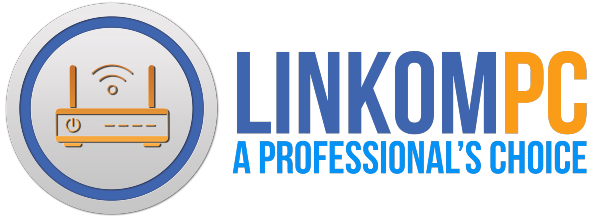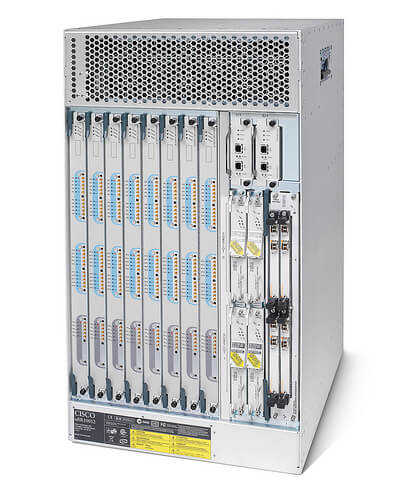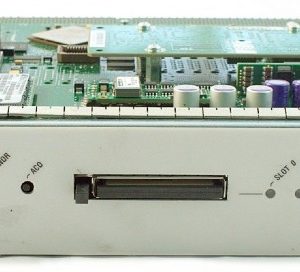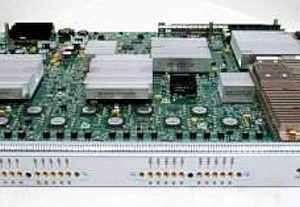
Cisco uBR10012 Universal Broadband Router CMTS
If you cannot find the product you are searching for, please request a quote or call us +381 11 414 0301.
WHY LINKOM-PC?
- Save 90%+ off list
- Professional Advice
- Fully Tested
- Fast Delivery
CISCO uBR10k EQUIPMENT click to buy:
UBR10012
UBR10-P4DT5G
UBR10-P4DT5G-HA
UBR10-P4DT10G
UBR10-P4DT10G-HA
UBR10-PWR-DC-PLUS
UBR10-PWR-AC-PLUS
UBR10-PWR-AC
UBR10-DTCC
ESR-PRE2
ESR-HH-CARRIER
ESR-HH-1GE
SFP-GE-T
ESR-PRE4
UBR10-PRE5
UBR-MC20X20V-20D
CAB-RFSW520QTIMF2
uBR-MC3GX60V
SPA-1X10GE-L-V2
Cisco uBR10012 Universal Broadband Router CMTS
The Cisco® uBR10012 Universal Broadband Router is a communications-grade cable modem termination
system (CMTS) that helps cable operators evolve their traditional cable infrastructures to an IP nextgenerationnetwork with superior reliability, performance, scale, and density. The Cisco uBR10012 (Figure1) supports large-scale delivery of advanced, revenue-generating IP services for business and residentialcustomers. The unique architecture of the Cisco uBR10012 brings unparalleled flexibility and intelligenceto the cable network with consistent high performance and sophisticated routing capabilities.
Next-Generation Technology Today
The Cisco uBR10012, which is qualified for PacketCableTM 1.0, DOCSIS® 2.0 and Euro-DOCSIS 1.1, and DOCSIS 3.0 Bronze, is built to meet the current and future needs of cable operators. Based on Cisco IOS® Software and featuring full Layer 3 routing capabilities, the Cisco uBR10012 offers advanced networking and routing options.
Beginning in Cisco IOS Software Release 12.3(13)BC, the product supports PacketCable Multimedia (PCMM),enabling cable operators to deploy unique, next-generation multimedia services such as voice over IP (VoIP), video telephony, and broadband online gaming. With Cisco IOS Software Release 12.3(13)BC or later, operators can optimize network utilization in real time for prioritized and aggregated resource demands from all PCMM applications and enhance the broadband subscriber experience by prioritizing or reserving bandwidth for latency-sensitive and feature-rich services. The CMTS fulfills service flow requests and now supports admission control – real-time decision making on a service-by-service request prior to committing CMTS or CMTS-controlled resources. Operators can establish policies for how resources are allocated among multiple services and can set thresholds for dealing with demand spikes.
The product also supports the CableLabs® OpenCable DOCSIS Set-Top Gateway (DSG) specification. DSG enables cable operators to transport upstream and downstream video traffic directly through the CMTS instead of through a proprietary, standalone video infrastructure. Incorporating out-of-band (OOB) messaging in DOCSIS digitally modulated carriers, cable operators can consolidate cable modem and set-top box (STB) data traffic on a shared DOCSIS channel. Features such as admission control and advanced traffic engineering, as well as advanced-mode DSG on their cable IP networks, help cable operators converge voice, video, and data traffic on their cable IP networks. Furthermore, Cisco is a leader in CMTS lawful intercept enablement. Cisco IOS Software Release 12.3(13)BC introduces Service-Independent Intercept (SII) support on the Cisco uBR10012. SII support assists operators in meeting the needs of law enforcement by providing a standards-based mechanism to intercept IP and voice traffic originating from, or destined to, subscribers on their network.
Wideband Enables New IP Services
Wideband uses advanced channel-bonding technology to deliver very high-speed broadband services – and enable a new generation of bandwidth-hungry IP services such as video over DOCSIS.
In addition to increasing the bandwidth available on the downstream, Cisco wideband also reduces cost. It does this using inexpensive, field-proven edge quadrature amplitude modulation (QAM) modulators such as the Cisco RFGW-1 and RFGW-10 models in order to increase the downstream capacity of the Cisco uBR10012 and reduce RF downstream costs. This enables cable operators to use the lower edge QAM port prices and to add new downstreams without adding additional upstreams at the same time.
Each Cisco uBR10012 chassis can support up to six Cisco 1-Gbps wideband shared port adapters (SPAs) by utilizing two SPA carrier cards installed in slots 1 and 2 in the I/O portion of the chassis along with at least one PRE- 4 processor. Equally important, these Wideband SPAs work in conjunction with the Cisco MC5X20H and uBRMC20X20V Broadband Processing Engines to increase the available downstream bandwidth of the Cisco uBR10012 system.
Communications-Grade Reliability
The Cisco uBR10012 delivers extremely high availability with fully redundant components, redundant backplane connections, N+1 RF line-card redundancy, and stateful switchover support, which help ensure uninterrupted service (Figure 1). The Cisco uBR10012 can be managed remotely and features field-upgradable software and hotswappable components.
The Cisco uBR10012 features these components:
● A maximum of eight RF line cards
● A maximum of six Wideband SPAs for Wideband channel bonding
● A maximum of two 4-SPA interface processors (SIPs), the carrier card for the Wideband SPAs
● A maximum of two WAN SPAs to connect to the IP backbone and external networks
● A maximum of two Cisco performance routing engine (PRE) modules
● Two Cisco Timing, Communication, and Control cards
● Two AC or DC power entry modules (PEMs) or two AC or DC 3300W power supplies
Modular Design for Investment Protection
The Cisco uBR10012 enables cable operators to deliver feature-rich, high-speed data, voice, and video services to very high subscriber penetrations. With a standards-based, modular design and upgrade flexibility, the Cisco uBR10012 provides cable operators with a quick return on investment and an easy migration path for future growth.
The Cisco uBR10012 supports the latest Cisco uBR-MC20X20V Broadband Processing Engine, which offers 20 downstream (Annex A or Annex B) and 20 upstream channels in which each downstream port is capable of carrying four frequency-stacked downstream channels. Each downstream channel of the Cisco uBR-MC20X20V Broadband Processing Engine is configurable as part of a DOCSIS 3.0 channel bonding group or DOCSIS 2.0/1.x channel (primary capable), and the total physical port count of the Cisco uBR-MC20X20V Broadband Processing Engine remains exactly the same as the Cisco 5x20H Broadband Processing Engine, which has 5 downstream ports and 20 upstream ports.
Consistent High Performance with Value-Added IP Services Supporting multiple services can strain existing cable networks. Operators must often make significant trade-offs concerning throughput, capacity, or service mix that can lower operating margins and create inconsistent service characteristics. With the Cisco uBR10012, multiple revenue-generating cable IP services can be deployed reliably
and with consistent performance.
The Cisco uBR10012’s PXF-based architecture helps ensure consistent line-rate throughput with multiple IP services enabled. A comprehensive suite of value-added IP services, such as quality of service (QoS), Multiprotocol Label Switching (MPLS), and access control lists (ACLs), has been performance-optimized to deliver exceptional throughput to every subscriber. With PCMM support, the Cisco uBR10012 now supports Dynamic QoS (D-QoS) for a range of new service offerings.
DOCSIS Set-Top Gateway Support
Traditionally, physical transport of OOB messaging is carried over dedicated channels as defined by the Society of Cable Telecommunication Engineers Digital Video Subcommittee (SCTE DVS) 167 and SCTE DVS 178. DSG Version 1.1 allows the Cisco uBR10012 to deliver OOB messages with just a software upgrade. Based on CableLabs OpenCable standards, DSG is a technology that bridges the traditional video environment with what can be considered “next-generation OOB.” DSG moves away from traditional OOB transport, incorporating it into DOCSIS digitally modulated carriers now used for cable modem service. The CMTS transports digital video OOB messaging/signaling between the video headend and subscriber digital STBs.
Consolidating cable modem and STB traffic over a common DOCSIS network enables cable operators to support new features and technology with minimal hardware change and offers an intelligent and more lasting network infrastructure that increases return on investment and reduces operating expenses. DSG adds the power of DOCSIS technology for new services, accelerating deployment of bandwidth-intensive, interactive video services such as online gaming and targeted advertising. Migration of OOB messaging traffic to an operationally superior and higher bandwidth DOCSIS channel is critical to adoption of interactive services. For these services, the traditional OOB mechanism (DVS 167 and DVS 178) is inefficient and provides insufficient bandwidth at a higher cost point.
Using Cisco IOS Software Release 12.3(13)BC or greater, advanced mode DSG, based on CM-SP-DSG-I04- 050408, is supported. Advanced mode DSG includes features such as downstream channel descriptors, regionalization, fragmentation, QoS, and enhanced security for multicast delivery of out-of-band messages dynamically to set-top boxes.
Applications
With the Cisco uBR10012, cable operators can deploy advanced cable IP services while supporting a large variety of applications, including:
● High-speed data (HSD)
● Managed access and tiered services
● Business services
● VoIP
● Video over IP
● VPNs
The Cisco uBR10012 offers an optimal solution to expand services and penetrate new markets. A mix of VoIP, VPN, IP Multicast, and basic HSD services is consistently, efficiently, and optimally supported throughout the network. The Cisco uBR10012 offers an ideal combination of density, reliability, flexibility, and performance (Table 1).
Table 1. Cisco uBR10012 Features and Benefits
Feature Description
Wideband channel bonding with modular CMTS architecture
● Enables efficient video delivery over IP
● Opportunity to scale services to meet new subscriber growth
● Cost-effective option to scale DOCSIS deployments PCMM support, PacketCable 1.0, as well as DOCSIS 2.0 and Euro-DOCSIS 1.1 qualified
● Protects investment and helps ensure compatibility with next-generation multiservice networks
● Provides QoS support, access lists, Multicast, MPLS traffic engineering
Highest density and scalability in the industry
● Reduces capital expenses
● Protects existing capital investment
High availability
● Reduces operational expenses
● Increases customer satisfaction
● Enables service-level agreements
● Enables delay-sensitive applications, such as voice and video
Specifications
Table 2 provides technical specifications for the Cisco uBR10012.
Table 2. Cisco uBR10012 Universal Broadband Router Hardware Specifications
Description Specification
Chassis 18 rack units with two chassis per 7-foot rack; fully configured chassis weight is 235 lb (106.6 kg); each chassis is 31.25 in. (79.4 cm) high, 17.2 in. (43.7 cm) wide, and 22.75 in. (57.8 cm) deep
Power DC input voltage of -48 to -60 VDC with 3000W maximum power consumption, 230 VAC option with 2400W maximum power consumption
Additional Powering Options:
1. DC input voltage of -40.5 to -72 VDC with 3300W maximum power consumption
2. 230 VAC, 3300W maximum power consumption
Temperature 41 to 104°F (5 to 40°C) operating and -40 to 158°F (-40 to 70°C) non-operating
Interfaces Eight line card slots; four LAN/WAN interface slots; interfaces include Gigabit Ethernet and Wideband SPA Compliance and emissions UL/CSA 60950-1, IEC/EN 60950-1, AS/NZS 60950.1, CAN/CSA 22.2 No. 950-95, EN 300 386 Regulatory FCC 47CFR15, Class B, CISPR22 Class B, EN55022 Class B, AS/NZS CISPR 22 Class B, ICES-003 Class B, VCCI Class B, IEC/EN61000-3-2, IEC/EN61000-3-3, IEC/EN61000-4-2, IEC/EN61000-4-3, IEC/EN61000-4-4, IEC/EN61000-4-5, IEC/EN61000-4-6, IEC/EN61000-4-11, designed to meet GR-1089-CORE NEBS EMC and Safety, Issue#5, GR-63-CORE NEBS Physical Protection, Issue#3.
Software support Cisco IOS Software Release 12.3(13)BC minimum to support PCMM, admission control, Advanced Mode DSG, and SII
Cisco 10000-SIP-600, Cisco 10000 Series SPA Interface Processor-600 10G
Cisco CAB-RFSW520QTIMF2, Quad-shield RF cable bundle, RF line card to HFC plant, 3m
Cisco EPC3928AD, Cisco Cable Modem 8×4 DOCSIS 3.0 Smart Dual Band Concurrent Wireless .11N Broadband Cable Gateway with voice EPC3928AD
€20,00CISCO EPC3928S, Cisco Cable Modem 8×4 DOCSIS 3.0 Residential Wireless Gateway with Digital Voice Model EPC3928S
€10,00Cisco ESR-PRE4, Performance Routing Engine 4
Cisco SPA-1X10GE-L-V2, Cisco 1-Port 10GE LAN-PHY Shared Port Adapter
€370,00Cisco SPA-5X1GE-V2, Cisco 5-Port Gigabit Ethernet Shared Port Adapter
€260,00Cisco UBR-MC20X20V-20D, UBR10K High-Perf D3.0 Card w/upx, 20US and 20DS License
Cisco UBR-MC3GX60V, D3.0 M-CMTS Line Card for uBR10K Platform; Base HW – 72US/60DS
Cisco UBR10-DTCC, DOCSIS Timing, Communication, and Control Card + DTI Client
Cisco UBR10-PRE5, Performance Routing Engine 5 For UBR10012 (2 x 10G)
Cisco UBR10012 chassis, UBR10012 chassis














